Covered with dense forests of mature mixed fir, deodar, oak, and flowering rhododendron trees, Kalatop Wildlife Sanctuary is located in the Chamba and Dalhousie subdivisions of Chamba district in Himachal Pradesh, India. Initially, this sanctuary was notified in 1958 with an area of 19.62 sq. km. The area was revised in 1989, covering 69.47 sq. km. In 2013, the Government of Himachal Pradesh, vide Notification No. FFE-B-F(6)-11/2005-II dated 7th June 2013, further revised the area of the sanctuary to 17.17 sq. km (1717 hectares).
The official name of the sanctuary is Kalatop Khajjiar Sanctuary, which derives from the famous historical “Khajji Nag” temple and the dense forests of Kalatop. “Kalatop” means “Black Cap” or “Black Top,” a name given because the dense canopy of trees creates a thick cover, resulting in a dark, shadowy environment even during the day, allowing very little sunlight to penetrate the forest floor. The dense branches form a natural umbrella, so even heavy rains do not penetrate easily, keeping visitors dry during the monsoon season.
The main places of attractions for the tourists of Kalatop Wildlife Sanctuary are Khajjiar Lake, the glade area, Kalatop, Pohlani Temple, and Dainkund. The area has many well-laid-out trekking trails at both Kalatop and Khajjiar, providing opportunities to witness the wildlife up close.
The Kalatop Wildlife Sanctuary is 9 km away from Dalhousie in North West direction and 24 Km from Chamba town in the North East direction.
Kalatop Wildlife Sanctuary Location, Boundary and Map
Kalatop Wildlife Sanctuary is located in the Western Himalayan Mountain ranges, specifically at the western extremity of the Dhauladhar Range. It reaches its highest point here before the range slopes down towards the Ravi River. The geographical coordinates of the sanctuary are as follows:
- North: Latitude 32° 33’ 58” N, Longitude 76° 01’ 11” E
- East: Latitude 32° 32’ 16” N, Longitude 76° 04’ 00” E
- South: Latitude 32° 31’ 27” N, Longitude 76° 01’ 51” E
- West: Latitude 32° 32’ 16” N, Longitude 76° 00’ 36” E
The Sanctuary is administered by the Khajjiar Wildlife Range under the Wild Life Division, Chamba. This range is divided into two blocks: The khajjiar block and Lakkarmandi block and consists of six beats: Khajjiar beat, Khajroth beat, Kalatop beat, Talai beat, Lakkarmandi beat, and Dainkund beat. The boundary description of the sanctuary is as follows:
- North: The Northern boundary extends from Pukari Galla to Devi Ghatu, then follows the boundaries of DPF Khajroth up to Kalatop RF C-11.
- East: The eastern side boundary starts from Devi Ghatu, along the boundary of Khajjiar DPF to Kanjredi Nalla, and then proceeds to its origin point at Bhagot.
- South: The southern boundary proceeding from Bhagot through Jhurdu Ridge up to Pohlani Temple.
- West: The western side boundary runs along the boundary of Kalatop RF from Pohlani Temple up to Kalatop RF C-11.
History of Kalatop Wildlife Sanctuary
The earliest records of managing the forests in the Kalatop and Khajjiar areas date back to 1850-1870 when Fir trees and Deodar were removed to supply timber for building construction in Dalhousie. Kalatop Wildlife Sanctuary has evolved significantly over the years, balancing conservation efforts with sustainable forest management practices.
- 1850-1870: During this period, Deodar and Fir trees were removed to meet construction needs in Dalhousie.
- 1871: Ribbentrop formulated the first forest working plan for the reserve forest of Kalatop and proposed the conversion of selective forestry into regular high forest management practices.
- 1886-1897: The D. Arcy Plan introduced major revisions to forest management strategies.
- 1896-1910: The D. Arcy plan was revised by Mc. Intires plan, focusing on further improvements in forest management and conservation.
- 1913-1933: The Mc. Intosh Plan continued to refine forest management practices.
- 1934-1954: The Kartar Singh Plan brought about comprehensive changes in forest management strategies.
- 1954-1968: The D.D. Mehta and Sant Ram’s plan emphasized sustainable forest practices.
- 1969-1984: The R.C. Sharma plan revised and updated existing forest management strategies.
- 1987: Administration of the area was transferred to the DFO, Wildlife Division Chamba, marking a shift towards integrated wildlife and forest management.
- 1995-2005: Sh. Nagin Nanda, IFS, developed the first dedicated wildlife management plan for the sanctuary, covering the period from 1995-96 to 2004-05.
- 1958: Initially notified as a sanctuary with an area of 19.62 sq. km., covering the Kalatop and Khajjiar areas.
- 1989: Responding to the seasonal wildlife migrations and to provide a buffer zone, the sanctuary’s boundaries were expanded northwards up to the Ravi River. This revision increased the total area to 69.47 sq. km. under Notification No. 6-2/73 SF-IV dated 26.09.1989.
- 2013: The sanctuary’s area was further refined and reduced to 17.17 sq. km. under the Government of Himachal Pradesh Notification No. FFE-B-F(6)-11/2005-II dated 7th June 2013, under the Wildlife (Protection) Act, 1972 provisions.
Kalatop Wildlife Sanctuary Photos : Deodar trees
Geography and Climate of Kalatop Wildlife Sanctuary
A. Geography:
Biogeographically, Kalatop Khajjiar Sanctuary is in the Western Himalayan Mountain zone, which separates two major faunal regions: the Oriental region to the south and the Palaearctic region to the north. The Kalatop Khajjiar Sanctuary area can be divided into three main types: dense forests, lake meadows, and a small area of alpine pasture. The dense forests comprise mature fir, spruce, deodar trees, some oak, and rhododendrons. The forest undergrowth is well-developed, dense in some areas, and has good grass cover.
1. Rock and Soil:
The mountainous terrain of the Kalatop Khajjiar Sanctuary is primarily composed of Silurian rocks, including slates, schists, and conglomerates. As you move south from Dalhousie-Khajjiar towards Chamba, through Lam Dal and Nag Dal up to Singhar Pass, the region transitions to granitoid and granitic gneisses, specifically the Dalhousie/Dhauladhar granite. This granite is characterized by quartz, plagioclase, feldspar, biotite, muscovite, and tourmaline.
Various types of underlying rock influence the soil composition. Sandy soils are produced in areas where the underlying rock is sandstone, quartzite, and siltstone. Clayey soils are typically found in areas underlain by slate, phyllite, schist, granite, and gneiss. Loamy soils are yielded in regions with limestone, shale, and litho assemblages.
The southern regions of the sanctuary have shallow and dry soil, along with many bare rock outcrops. However, the forested areas contain deep, fertile soil that can sustain robust tree growth.
2. Terrain:
The terrain of the sanctuary comprises moderately steep to steep slopes covered with a dense vegetative canopy, situated on the Western Dhauladhar range. The forests are generally accessible, with only a few steep sections along the streams.
Kalatop Wildlife Sanctuary Photo : Glade area Khajjiar
B. Climate:
1. Rainfall:
Kalatop Wildlife Sanctuary experiences a varied climate with distinct seasonal patterns of rainfall and snowfall. The region receives most of its precipitation during the monsoon season, typically from June to September. During the winter season, rainfall occurs in the form of both rain and snow.
The sanctuary receives significant rainfall in July and August, with August being the wettest month. The average yearly rainfall in the area is approximately 71.42 mm. The climate of the area supports lush vegetation and diverse ecosystems, contributing to the sanctuary’s rich biodiversity.
2. Snowfall:
Snowfall occurs in Kalatop Wildlife Sanctuary mainly during the winter months and varies each year. January often gets the most ranging from 12.70 cm to 254 cm. February also varies, from 5.08 cm to 91.44 cm. March sometimes sees light snow and other months usually have little or none. December can also have significant snow, ranging from 5.08 cm to 116.84 cm. The sanctuary’s snowfall adds to its diverse climate and environment.
3. Temperature:
In the sanctuary, colder temperatures prevail at higher elevations, while the climate becomes slightly warmer as you descend towards the north. In summer, temperatures can soar to 30°C or higher in the lower areas, but higher elevations maintain a pleasant climate. During winter, sub-zero temperatures are common at higher elevations.
4. Water Sources:
The water streams in the area are perennial, with numerous springs and aquifers providing abundant clean water. However, during peak summer at higher elevations, water becomes scarce, and animals may descend to stream beds. Except for Khajjiar Lake, there are no marshes or stagnant water bodies. The main streams are Khajjiar Nalla, Jhurdu Nalla, Sach Nalla, Khajroth Nalla, Karelnu Nalla, Topi Nalla, Lakkermandi Nalla, Rai Nalla, Makhol Nalla, Narbah Nalla, and Kanjredi Nalla. These streams form the catchment of the Ravi River, an important tributary of the Indus River system.
Kalatop Wildlife Sanctuary Animals
The varied climate and different environmental conditions in Kalatop Khajjiar Wildlife Sanctuary support a range of habitats and natural systems, along with many types of life forms.
1. Forest:
This area is known for its rich variety of plants, with 232 plant species from 76 families and 218 genera. Out of the 100 medicinal plant species recorded in the Kalatop Khajjiar Wildlife Sanctuary, seven are classified as threatened. These include Dioscorea deltoidea, Paris polyphylla, Polygonatum verticillatum, Podophyllum hexandrum, Taxus wallichiana, Cinnamomum tamala, and Zanthoxylum armatum.
The Moist Deodar Forests are common around and below Khajjiar and the Kalatop Forest Rest House. In this area, the forest is almost entirely Deodar. This type of forest covers most of Kalatop RF, except for the compartment above Lakkarmandi-Khajjiar road, and DPF Khajjiar.
Western Mixed Coniferous Forests type mainly found above the Lakkarmandi-Khajjiar road, DPF Jhurdu, and DPF Khajroth, features deciduous trees such as Acer species, Aesculus indica, Celtis australis, Juglans regia, and Litsea species. The undergrowth includes Deutzia, Lonicera, Potentilla, Viola, and Viburnum species.
The main plants associated with Ban Oak forests are Rhododendron arboreum and Pieris ovalifolia. Most of the Demarcated Protected Forests of Karangra Rakh falls under this type of forest.
2. Animals:
The sanctuary provides a good habitat for the endangered Musk deer. Other animals found here include the Black bear, Rhesus monkey, common leopard, barking deer, Yellow-throated marten, Flying squirrel, Goral, Himalayan weasel, langur, and Himalayan fox. In terms of animal variety, there are 16 species of mammals and 110 species of birds. Furthermore, 49 species of butterflies have been reported from the Khajjiar Lake catchment area.
The musk deer is small not more than 50 cm high at the shoulder. The confirmed presence of Musk Deer is recorded on the Lakkermandi-Kalatop road.
The goral can be spotted in the Kalatop, Khajrot, Lakkermandi, and Talai beats, where the area is healthy and supportive for them.
The Gaula, or Chamba Sacred Langur, is only found in the forests around Chamba. They live in groups of 20 to 30 members. There are nine types of langurs in India, with three in northern India, including the Gaula. They have dark forearms, and long brownish-grey coats, and males have manes. Gaulas eat leaves, buds, bark, fruit, roots, seeds, cones, and flowers. They also lick soil and love young leaves.
Kalatop Wildlife Sanctuary Photos : Chamba Sacred Langur
Tourism
Every year about 4-5 lacs tourists visit Kalatop Wildlife Sanctuary to enjoy its natural scenic beauty and pleasant weather. Tourists come here to visit the Kalatop, Khajjiar lake, the glade area, Pohlani temple, and Dainkund. This area of the Kalatop Wildlife Sanctuary is famous for its unparalleled natural beauty with its perennial streams, waterfalls, and excellent spots for adventure activities like trekking, hiking, and camping. The dense forests, wetlands, glades, and camping grounds make it an attractive destination for tourists and wildlife enthusiasts. Its scenic landscapes and outdoor opportunities hold significant potential for tourism development.
Dalhousie to Kalatop Wildlife Sanctuary distance is just 9km. As Dalhousie is very near the sanctuary many tourists come here to visit especially during summer April to July. The daily wagers engaged through the Eco-Tourism Society cleared the littering done by tourists.
Tourist visit data for the last five years is as follows:
| Sr. No | Year | Number of Tourists Visited |
| 1. | 2013-14 | 293946 |
| 2. | 2014-15 | 248313 |
| 3. | 2015-16 | 367166 |
| 4. | 2016-17 | 489310 |
| 5. | 2017-18 | 523936 |
How to visit Kalatop Wildlife Sanctuary
1. Daikund Peak Trekking
The Kalatop Wildlife Sanctuary distance from Dalhousie is 9 km away to the northwest direction, and Dainkund, located within the sanctuary, is about 15 km from Dalhousie. From Lakkarmandi, the Pohlani Mata Temple located on Dainkund Peak is 5.5 km away. However, trekking to Dainkund from Lakkarmandi through moderate hilly terrain with beautiful scenes, scenery, and meadows is 1 km, and the Pohlani Mata Temple is a 1.5 km trek.
Although this trek is hilly, it is not very difficult because there is a well-defined path. Sign boards are everywhere, letting you know how much distance you will be required to trek to reach Pohlani Mata Temple. Many wildflowers are on the way which enhance the beauty of this trek.
The first glimpse of the Mata Temple is from 200 meters before reaching the temple. This is a temple of Kali Mata. It is said that earlier a witch used to live in this hill and whoever passed through this hill was eaten by her. It is said that because of that, Palani Mata appeared here and protected the people by killing the witch here and since then, Pohlani Mata has been worshiped here. Dainkund Peak offers spectacular views of the valley below.
Kalatop Wildlife Sanctuary Photos : Pohlani Mata Temple
2. Kalatop Trekking
The road divides from Lakkarmandi where by taking one road one can reach Khajjiar and by taking the other road you can go inside Kalatop Wildlife Sanctuary which is 3km. You can enter the Kalatop Forest by car or also enter trekking on foot. Kalatop Wildlife Sanctuary entry fee is ₹ 200. There is a forest rest house which is worth visiting. This is a 3 km complete off-roading trek through the Deodar Forest. There were so many forests and tall trees in this forest due to which sunlight did not reach the ground below and that is why this forest is known as Kalatop Forest.
Later the trees here were brought down to the bottom and a market was built there to sell the wood and that is why the place from where the road for Kalatop forest starts is known as Lakkar Mandi.
The Forest Rest House of Kalatop Forest is beautifully located on the hilltop above 8000 feet of sea level. The rest house is built in the British style and it was established in 1925. There are also accommodation facilities which you can avail of after getting permission from the Forest Department. There is a sunset point on the back side of the rest house, from where you can enjoy the sunset. The backyard of the rest house is very beautiful having well well-prepared lawn surrounded by trees.
In this wildlife century, the song of the movie 1942 love story “Ek Ladki Ko Dekha To Aisa Laga” was shot here. The last scene of the Lootera movie, when Sonakshi Sinha was sitting inside a house and it was snowing outside, was also shot here.
Kalatop Wildlife Sanctuary timings 9 am to 6 pm after which it is almost complete silence.
Kalatop Khajjiar Sanctuary Photos: Forest Rest House at Kalatop
3. Khajjiar: The Switzerland of Himachal Pradesh
Khajjiar is a hill station located near Chamba town in the district of Chamba, Himachal Pradesh, India, and is a major tourist attraction known as the “Mini Switzerland of Himachal Pradesh.” It is about 2,000 meters above sea level and situated in the foothills of the Dhauladhar ranges of the Western Himalayas. It is part of the Kalatop Khajjiar Sanctuary and is approximately 24 km from Dalhousie.
Khajjiar’s proximity to the plains of Punjab and Jammu Kashmir makes it an easily accessible destination for tourists. Its serene and unspoiled beauty provides a perfect atmosphere for visitors. This beautiful glade, nestled among coniferous forests, attracts many tourists.
On July 7, 1992, Mr. Walter Leu, Director General of the Swiss National Tourist Office, put Khajjiar on the world tourism map by recognizing it as the “Switzerland of Himachal Pradesh.” He installed a yellow Swiss hiking footpath sign showing Khajjiar’s distance from Bern, Switzerland: 6,194 km (3,849 miles). Khajjiar is one of 160 locations worldwide that resemble Switzerland’s topography. Mr. Leu also took a stone from Khajjiar to be part of a stone collage around the Swiss Parliament, serving as a reminder of Khajjiar as the “Mini Switzerland of India.”
a. Dauladhar mountains:
Khajjiar is known for its dense deodar and pine forests, as well as its lush green meadows. As it is located at the base of the Dhauladhar mountains, it offers tourists panoramic views of the mountains.
b. Khajjiar Lake:
Khajjiar Lake is a small, saucer-shaped lake surrounded by lush green meadows. It is a popular tourist destination and a unique high-altitude wetland in the Ravi River catchment. The total surface area of Khajjiar Lake is 28368 Sqm. The catchment of the Khajjiar Lake mainly drains through four major nallas namely 1. Mother Tree Nalla 2. Jhurdu Nalla 3. Bhathli Nalla and 4. Devi Da Ghatta Nalla.
c. Khajji Nag temple:
Near the Khajjiar lake, there is the Khajji Nag Temple, built in the 12th century CE by King Prithvi Singh of Chamba. Known as the Golden Devi Temple due to its golden dome, the temple features images of the Pandavas and the defeated Kauravas hanging in the mandapa. The sanctum is carved from wood and is dedicated to snake worship, with several snake idols inside. The temple also contains idols of Shiva and the Goddess Hadimba.
d. Trekking from Khajjiar to Dainkund:
Khajjiar provides many trekking options, including the 3.5-kilometer Khajjiar to Dainkund trek. Starting 6 km from Khajjiar on the Dalhousie-Khajjiar Road, it leads to the Pholani Devi Temple at Dainkund. This trek, suitable for beginners and children, features a well-marked trail with moderate uphill sections. It offers stunning views and a scenic camping spot along the way.
In Khajjiar, tourists can stay at a hotel and several cottages managed by HP Tourism. there are also two rest houses, one operated by the P.W.D. and another by the Forest Department. Private hotels have also been established in the area. Accommodation options include rooms at the Forest Rest House Khajjiar with 2 bedrooms, a Transit Hut with 1 bedroom, a Trekker Hut with 2 bedrooms, and a Dormitory with 4 beds.
Kalatop Khajjiar Sanctuary Photos: Khajjiar Lake
How to Reach Kalatop Wildlife Sanctuary
This sanctuary is easily reachable by road from Dalhousie as well as Chamba. The road from Dalhousie to Kalatop Wildlife Sanctuary is 9 km and remains closed due to snowfall during the winter season.
- By Railway: The nearest Railway station to the sanctuary is Pathankot which is 90 km away.
- By air: Gaggal (Kangra) Airport is 130 km away.
- By road: From Chandigarh to Dalhousie is 352 km, then to Lakkadmandi is another 9 km. Kalatop is 3 km further, and Khajjiar is another 12 km. Alternatively, it’s 25 km from Chamba to Khajjiar.
The roads providing connectivity to the sanctuary are as follows:
- Dalhousie to Lakkarmandi: 9 km, motorable road.
- Chamba to Miarigalla: 20 km, motorable road.
- Chahla to Chilbungla-Talai: 7 km, bridle path.
- Chaned to Kohlari: 6 km, jeepable.
- Chaned to Singi-Khajjiar: 10 km, bridle path.
- Sitla Bridge to Miarigalla: 13 km, jeepable.
- Dalhousie to Talai-Parel: 40 km, jeepable.
- Devidehra to Talai: 5 km, bridle path.
- Sultanpur to Khajjiar via Sach: 8 km, bridle path
The Best Time to Visit Kalatop Wildlife Sanctuary
The Kalatop Wildlife Sanctuary remains accessible during the summer also. Large numbers of tourists come to visit the places like Khajjiar, Kalatop, and Daikund. The best times to visit the places are from April to mid-June and September to November. However, due to its easy accessibility, tourists also visit during the off-season. From April to July, tourist influx is very high in the Kalatop Wildlife Sanctuary.
Where to stay
To provide better facilities for stay, the Rest houses and Trekker Huts available inside the Kalatop Wildlife Sanctuary such as Forest Rest House Khajjiar, Forest Rest House Kalatop, Trekker Huts Kalatop, Transit Hut Khajjiar, Hotels in Dalhousie, Khajjiar, Kalatop, and Lakkarmandi. Watch towers at convenient and suitable points are also there, where visitors can have an overview of the area as well as a close-up of wild animals.
Conclusion
Kalatop Wildlife Sanctuary, located in the Chamba and Dalhousie subdivisions of Chamba district in Himachal Pradesh covering 17.17 sq. km with Moist Deodar Forest, Western mixed coniferous forest, and Ban Oak Forest in the Himalaya Biographic zone is famous for its major attraction places like the Kalatop, Khajjiar lake, the glade area, Pohlani temple, and Dainkund. Every year about 4-5 lacs tourists visit this Sanctuary to enjoy its natural scenic beauty and pleasant weather.
Notified in 1958, this sanctuary with its perennial streams, waterfalls, dense forests, wetlands, glades, and scenic landscapes is an excellent spot for adventure activities like trekking, hiking, and camping. The best times to visit Kalatop Wildlife Sanctuary are from April to mid-June and September to November.
FAQ
a. What is the Kalatop Wildlife Sanctuary famous for?
Kalatop Wildlife Sanctuary is famous for its unparalleled natural beauty with its perennial streams, waterfalls, and excellent spots for adventure activities like trekking, hiking, and camping. The dense forests, wetlands, glades, and camping grounds make it an attractive destination for tourists and wildlife enthusiasts. Tourists come here to visit the Kalatop, Khajjiar lake, the glade area, Pohlani temple, and Dainkund.
b. What animals are in the Kalatop?
The confirmed photo evidence of Musk Deer’s presence is recorded on Lakkermandi-Kalatop road. The goral can be spotted in the Kalatop, Khajrot, Lakkermandi, and Talai beats. The Gaula, or Chamba Sacred Langur, is only found in the forests around Chamba. They live in groups of 20 to 30 members. Other animals found here include the Black bear, Rhesus monkey, common leopard, barking deer, Yellow-throated marten, Flying squirrel, Goral, Himalayan weasel, langur, and Himalayan fox.
c. How to visit Kalatop Wildlife Sanctuary?
To visit Kalatop Wildlife Sanctuary, you can fly to Gaggal (Kangra) Airport, which is 130 km away, or take a train to Pathankot, 90 km away. By road, it’s 352 km from Chandigarh to Dalhousie, then 10 km to Lakkadmandi, 3 km to Kalatop, and another 12 km to Khajjiar. Alternatively, it’s 25 km from Chamba to Khajjiar.
d. How long is Kalatop trek?
The Kalatop trek is a 3 km complete off-roading trek through the Deodar Forest from Lakkermandi to Kalatop Forest rest house located in Kalatop Wildlife Sanctuary. There were many forests and tall trees in this forest due to which sunlight did not reach the ground below and that is why this forest is known as Kalatop Forest.
You May Also Like
- Nargu Wildlife Sanctuary
- Kanawar Wildlife Sanctuary
- Simbalbara National Park
- Pin Valley National Park
- Khirganga National Park


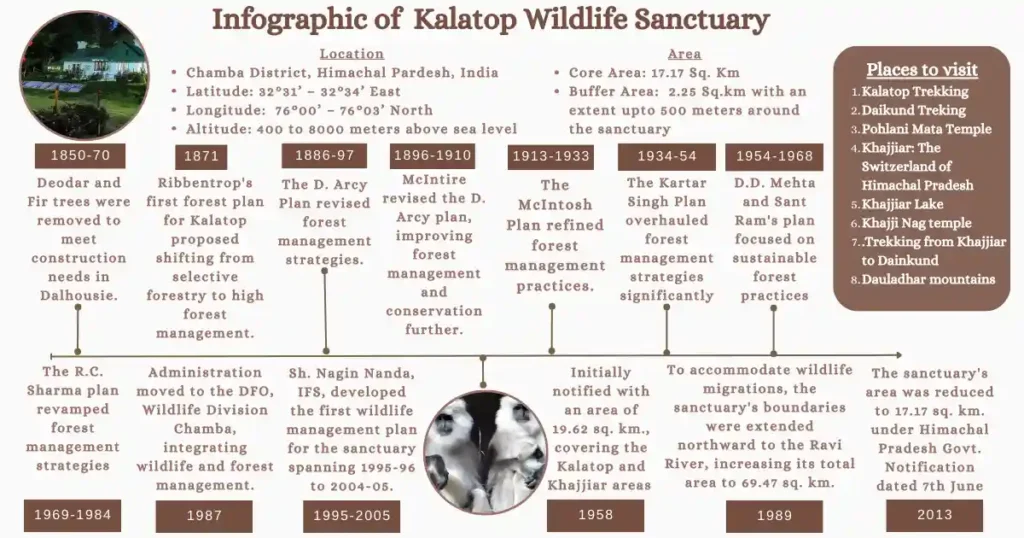

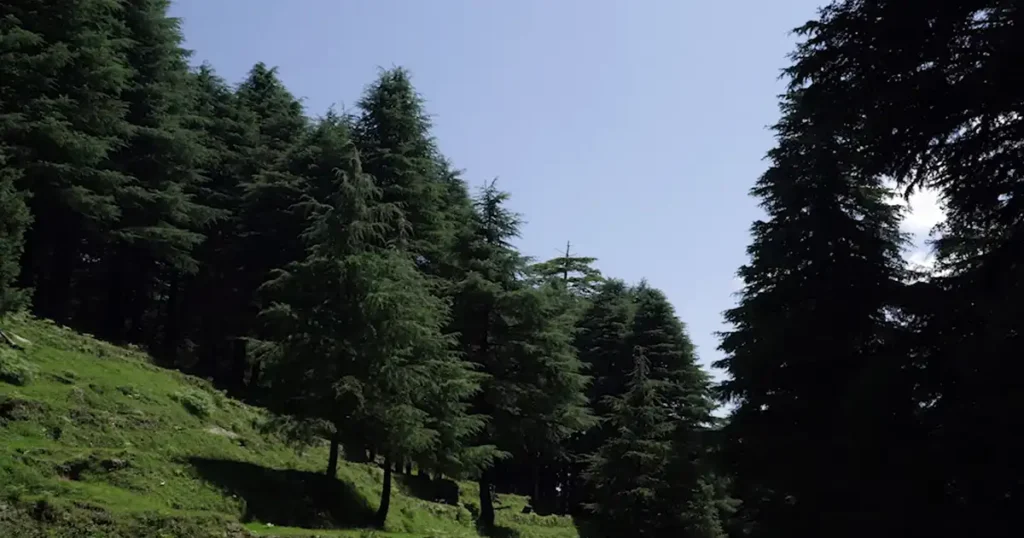
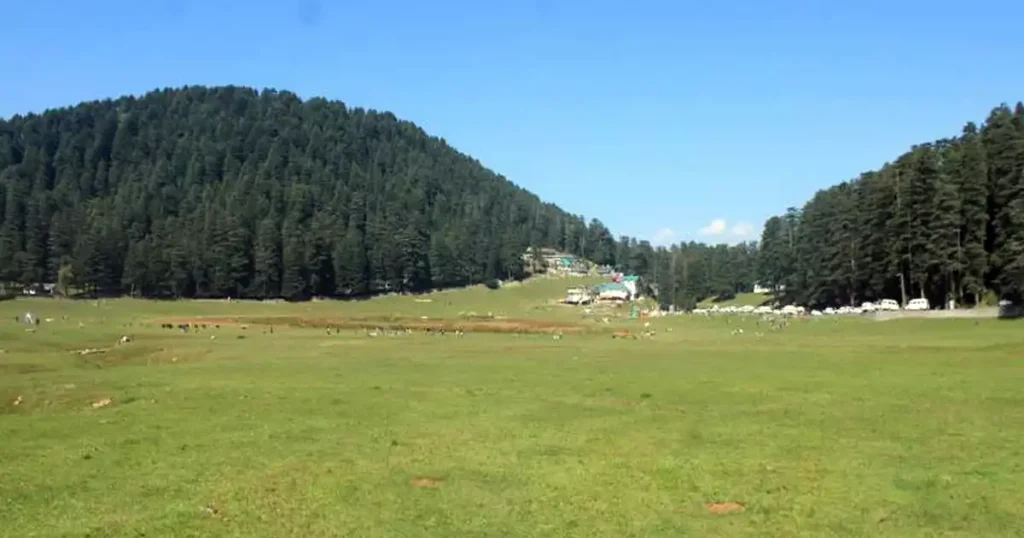
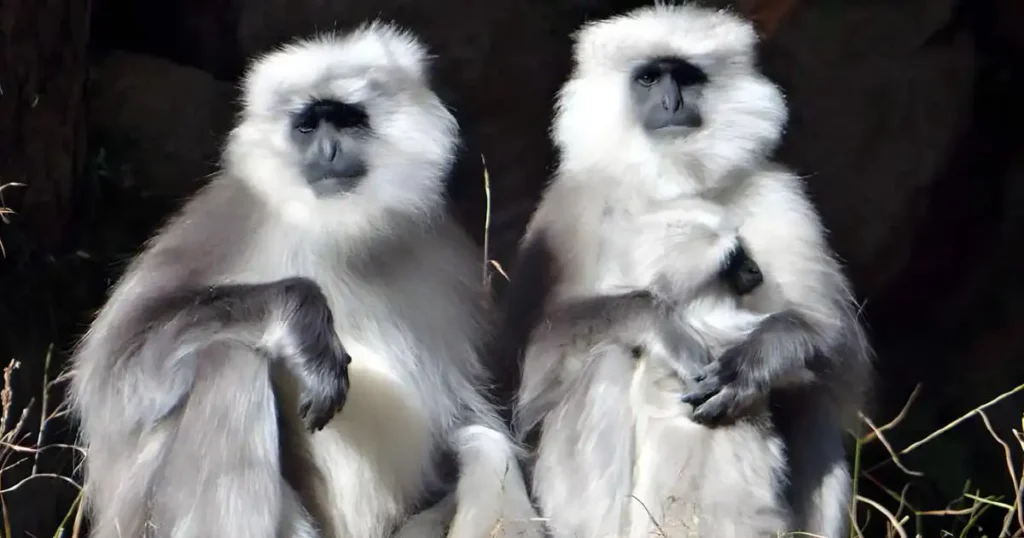
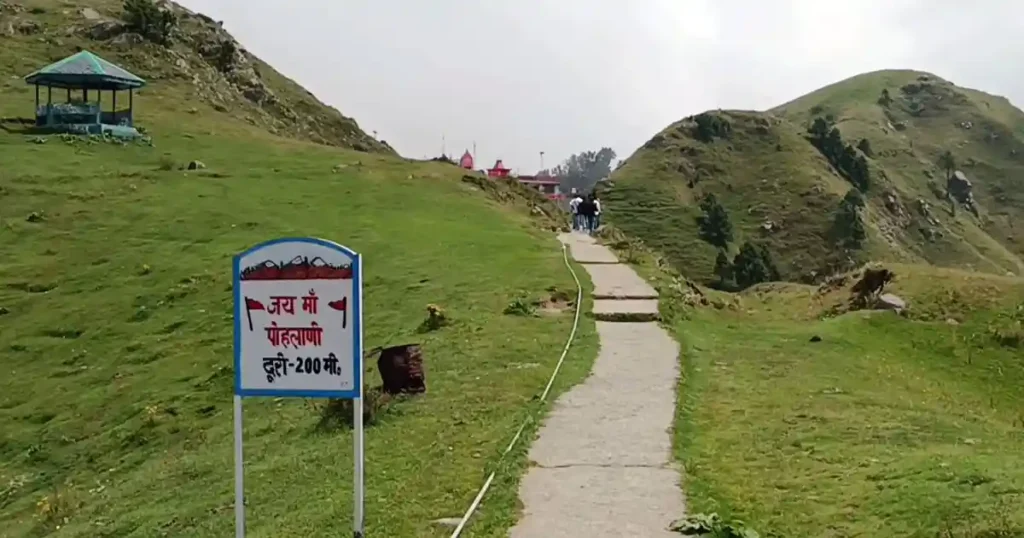
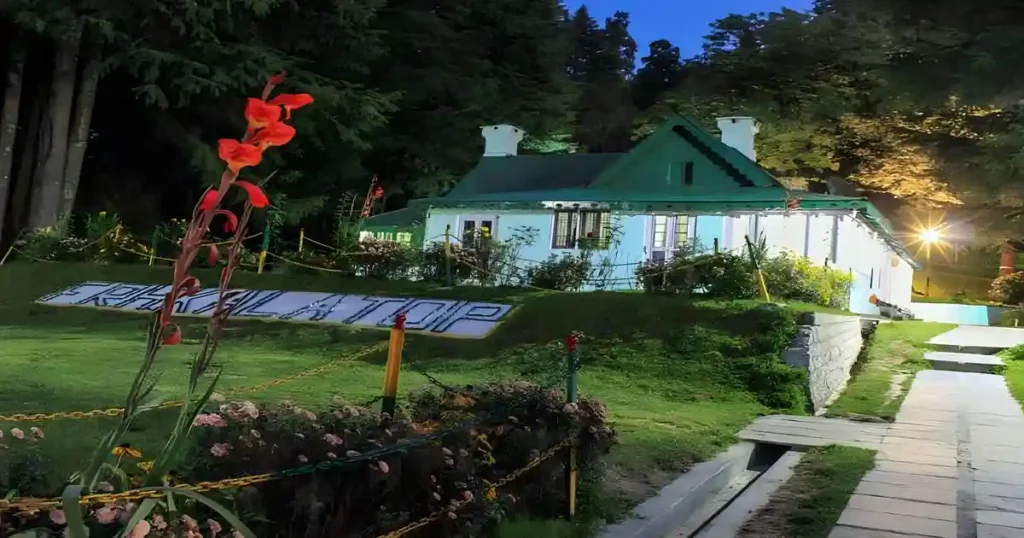
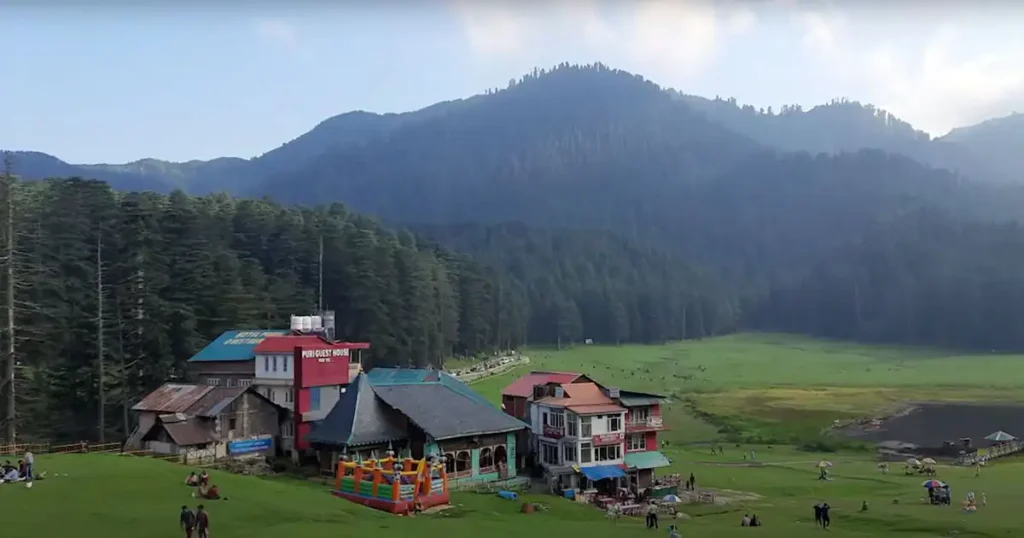

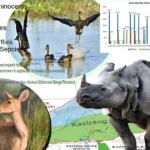
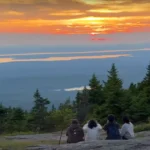
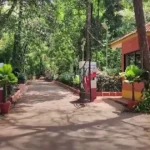
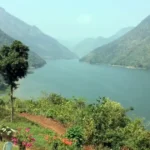


2 thoughts on “Kalatop Wildlife Sanctuary”